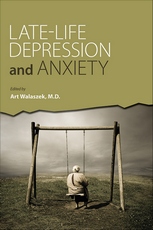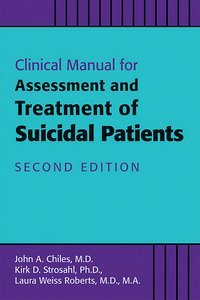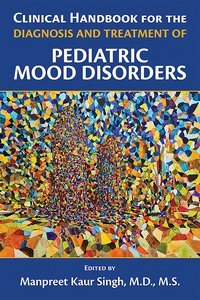The American Psychiatric Association Publishing Textbook of Mood Disorders, Second Edition
View Pricing
Description
This new edition of The American Psychiatric Association Publishing Textbook of Mood Disorders is a systematic and painstaking reconceptualization of its predecessor. Under new editorial direction and with a revised roster of expert contributors, the second edition is an utterly current, clinically competent, and comprehensive text that will become an instant classic. The book is structured for learning and easy reference, moving deftly from symptomatology and epidemiology to pathogenesis and on to somatic interventions, cognitive-behavioral interventions, and psychotherapy. The latest science on genetics and epigenetics, brain imaging, and neurobiology are also examined in depth. Critically important to the clinician is the section on management of mood disorders, which provides treatment guidelines for major depressive disorder and bipolar disorder, as well as information on understanding, and preventing, suicide in children, adolescents, and adults. Finally, perspectives are offered on depression among women, children, and geriatric patients, as well as on depression across cultures. Practicing psychiatrists, residents, and students alike will benefit from the book's inclusive coverage.
Topics new to this edition include the following:
- Treatment-resistant depression—its definition and approaches to its treatment—is addressed in a dedicated chapter that covers diagnostic accuracy, pseudoresistance, comorbidity, pharmacological management, adjunctive strategies, psychotherapy, neuromodulation, and novel and experimental therapies.
- Investigational agents, most notably ketamine and its relatives, constitute an exciting frontier in the treatment of mood disorders, and the clinical application, routes of delivery, dosing, risks, and clinical trials are explored in a dedicated chapter that is both rigorous and thorough.
- There is compelling evidence that childhood maltreatment (defined as exposure to emotional, physical, and sexual abuse and neglect before the age of 18 years) is a prominent risk factor for the development of mood disorders as well as for a pernicious course and poor treatment response in mood disorders. These findings, as well as the underlying neurobiological and environmental interactions that may contribute to the development of mood disorders, are examined thoroughly and thoughtfully.
- As our understanding of immune function in mood disorders has grown, psychoneuroimmunology has emerged as a focus of study likely to make major contributions to clinical practice in the coming decades. The book updates readers on this promising area of research.
Over the last decade, depression has emerged as the leading cause of disability worldwide, with significant attendant morbidity and mortality. The American Psychiatric Association Publishing Textbook of Mood Disorders equips clinicians and trainees with the knowledge they need to alleviate suffering in their patients with mood disorders.
Contents
- Contributors
- Preface
Part I: Symptomatology and Epidemiology
- Chapter 1. Historical Aspects of Mood Disorders
- Chapter 2. Classifications of Mood Disorders
- Chapter 3. The Epidemiology and Burdens of Mood Disorders
- Chapter 4. Rating Scales and Structured Diagnostic Interviews for Mood Disorders
Part II: Pathogenesis of Mood Disorders
- Chapter 5. Neurochemistry of Mood Disorders
- Chapter 6. Psychoneuroendocrinology of Mood Disorders
- Chapter 7. Role of the Immune System in Mood Disorders
- Chapter 8. Evolutionary Contributions to the Understanding of Mood and Mood Disorders
Part III: Investigating Mood Disorders
- Chapter 9. Anatomical Pathology
- Chapter 10. Molecular and Cellular Neurobiology of Severe Mood Disorders
- Chapter 11. Brain Imaging
- Chapter 12. Review of Mood Disorder Genetics
- Chapter 13. Epigenetics of Mood Disorders
Part IV: Somatic Interventions for Mood Disorders
- Chapter 14. Tricyclics, Tetracyclics, and Monoamine Oxidase Inhibitors
- Chapter 15. Selective Serotonin Reuptake Inhibitors, Serotonin-Norepinephrine Reuptake Inhibitors, and Other Related Antidepressants
- Chapter 16. Lithium and Mood Stabilizers
- Chapter 17. Use of Antipsychotic Medications in Mood Disorders
- Chapter 18. Electroconvulsive Therapy in the Treatment of Mood Disorders
- Chapter 19. Transcranial Magnetic Stimulation for Major Depressive Disorder
- Chapter 20. Vagus Nerve Stimulation and Deep Brain Stimulation
- Chapter 21. Other Antidepressants: Trazadone, Mirtazapine, Bupropion
- Chapter 22. Ketamine and Other Investigational Agents
Part V: Psychotherapy of Mood Disorders
- Chapter 23. Cognitive and Behavior Therapies for Major Depressive Disorder and Persistent Depressive Disorder
- Chapter 24. Interpersonal Psychotherapy for Major Depressive Disorder and Persistent Depressive Disorder
- Chapter 25. Psychoanalytic and Psychodynamic Psychotherapy for Depression and Dysthymia
- Chapter 26. Psychotherapeutic Approaches to Bipolar Disorder
- Chapter 27. Psychotherapy for Depression in Children and Adolescents
Part VI: Integrative Management of Mood Disorders
- Chapter 28. Practice Guidelines for Major Depressive Disorder
- Chapter 29. Guidelines for Treatment of Bipolar Disorder
- Chapter 30. Understanding and Preventing Suicide
- Chapter 31. Suicide in Children and Adolescents
- Chapter 32. Combination Strategies for the Pharmacological Treatment of Major Depressive Disorder
- Chapter 33. Management of Treatment-Resistant Depression
Part VII: Subtypes of Mood Disorders
- Chapter 34. Seasonal Affective Disorder and Light Therapy for Mood Disorders
- Chapter 35. Atypical Depression, Dysthymia, and Cyclothymia
- Chapter 36. Major Depressive Disorder With Psychotic Features
- Chapter 37. Pediatric Mood Disorders
- Chapter 38. Geriatric Mood Disorders
Part VIII: Additional Perspectives on Mood Disorder
- Chapter 39. Depression in Primary Care
- Chapter 40. Depression in Medical Illness
- Chapter 41. Mood Disorders and Substance Use
- Chapter 42. Depression in Women
- Chapter 43. Depression Across Cultures: An Ecosocial Approach
- Chapter 44. Mood Disorders and Sleep
- Chapter 45. Childhood Maltreatment and Mood Disorders
- Index
Contributors
- Joan Asarnow, Ph.D.
Yuanhan Bai, M.D., M.S.
Wade Berrettini, M.D., Ph.D.
Michele A. Bertocci, Ph.D.
Pierre Blier, M.D., Ph.D.
Martin Brune, M.D., Ph.D.
Joseph R. Calabrese, M.D.
Kenneth Carpenter, Ph.D.
Linda L. Carpenter, M.D.
Frances A. Champagne, Ph.D.
Adora Choquette, B.A.
Samuel J. Collier, M.D.
William Coryell, M.D.
W. Edward Craighead, Ph.D.
Larry Culpepper, M.D., M.P.H.
Jorge Renner Cardoso de Almeida, M.D., Ph.D.
Charles DeBattista, M.D.
J. Raymond DePaulo Jr., M.D.
Adel Farah, M.D., M.Sc.
Andrew M. Fukuda M.D., Ph.D.
Glen O. Gabbard, M.D.
Keming Gao, M.D., Ph.D.
Charles F. Gillespie, M.D., Ph.D.
Benjamin Goldstein, M.D., Ph.D.
Ana Gomez-Carrillo, M.D.
Ilang M. Guiroy, M.D.
Deborah Hasin, Ph.D.
Jennifer L. Hughes, Ph.D., M.P.H.
G. Eric Jarvis, M.D.
Ronald C. Kessler, Ph.D.
Hannah M. Kilian, M.Sc.
Laurence J. Kirmayer, M.D.
Brandon M. Kitay, M.D., Ph.D.
Teresa Lanza di Scalea, M.D., Ph.D.
David A. Lewis, M.D.
John T.P. Liggins, M.D., M.S.
Elizabeth T.P. Lippard, Ph.D.
Matthew Macaluso, D.O., DFAPA
Dean F. MacKinnon, M.D.
J. John Mann, M.D.
John C. Markowitz, M.D.
William V. McCall, M.D., M.S.
William McDonald, M.D.
Dora M. Meyer, M.Sc.
David J. Miklowitz, Ph.D.
Melissa P.H. Miller, M.Sc.
Trevor Mooney, M.D.
Christine Yu Moutier, M.D.
Dominique Musselman, M.D., M.S.C.R.
Alison Myoraku, M.S.
Henry A. Nasrallah, M.D.
Charles B. Nemeroff, M.D., Ph.D.
Maria Antonietta Nettis, M.D., Ph.D.
D. Jeffrey Newport, M.D., M.S.
Andrew A. Nierenberg, M.D.
Edward Nunes, M.D.
Lexi Nutkiewicz, B.A.
Lisa A. O'Donnell, Ph.D.
Dan A. Oren, M.D.
Vanessa Padilla, M.D.
Carmine Maria Pariante, M.D., Ph.D., FRCPsych
Brenda W.J.H. Penninx, M.D., Ph.D.
Mary L. Phillips, M.D., M.D. (Cantab)
Grazyna Rajkowska, Ph.D.
Natalie Rasgon, M.D., Ph.D.
Darrel A. Regier, M.D., M.P.H.
Mina M. Rizk, M.B.B.Ch., M.Sc.
Mitchell Rovner, M.D.
Eric Rubin, M.D., Ph.D.
James K. Rustad, M.D.
Gerard Sanacora, M.D., Ph.D.
Alan F. Schatzberg, M.D.
Thomas E. Schlaepfer, M.D.
Marianne Seney, Ph.D.
Luca Sforzini, M.D.
David V. Sheehan, M.D., M.B.A.
Richard C. Shelton, M.D.
Manpreet K. Singh, M.D., M.S.
David C. Steffens, M.D., M.H.S.
Stephen M. Strakowski, M.D.
Caroline Symcox, B.Sc.
Michael E. Thase, M.D.
Martha C. Tompson, Ph.D.
Marisa Toups, M.D.
Philip S. Wang, M.D., Dr.P.H.
Frances Isabella Weston, B.Sc.
Daniel R. Wilson, M.D., Ph.D.
Hans-Ulrich Wittchen, Ph.D.
Tyler Wright, M.D., M.P.H.
Brian W. Wu, M.D., Ph.D.
Zhixing Yao, M.D.
Lakshmi N. Yatham, M.B.B.S., FRCPC
Shiwen Yuan, M.D.
Kristina F. Zdanys, M.D.
Hannah N. Ziobrowski, Ph.D., M.P.H.
About the Authors
Charles B. Nemeroff, M.D., Ph.D., is the Matthew P. Nemeroff Professor and Chair of the Department of Psychiatry & Behavioral Sciences at the University of Texas, Austin, Dell Medical School.
Natalie Rasgon, M.D., Ph.D., is a Professor in the Department of Psychiatry and Behavioral Sciences and Obstetrics and Gynecology at Stanford University School of Medicine and is also the Director of the Stanford Center for Neuroscience in Women's Health and the Associate Dean of Academic Affairs.
Alan F. Schatzberg, M.D., is Kenneth T. Norris, Jr., Professor in the Department of Psychiatry and Behavioral Sciences at Stanford University School of Medicine in Stanford, California, where from 1991 to 2010 he was also the Chair of Psychiatry. He is currently Director of the Stanford Mood Disorders Center.
Stephen M. Strakowski, M.D., is Vice Dean of Research and Associate Vice President, Regional Mental Health, at the Dell Medical School, University of Texas at Austin. He is also Professor of Psychiatry & Behavioral Sciences, Psychology, and Educational Psychology at the University of Texas, Austin.
Related Products
Carousel Control - items will scroll by tabbing through them, otherwise arrows can be used to scroll one item at a time








